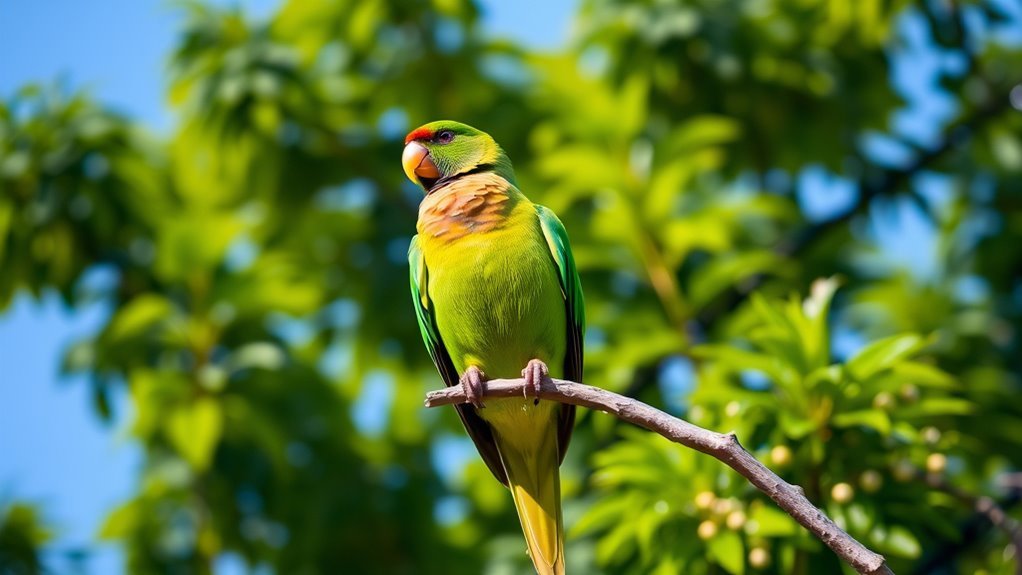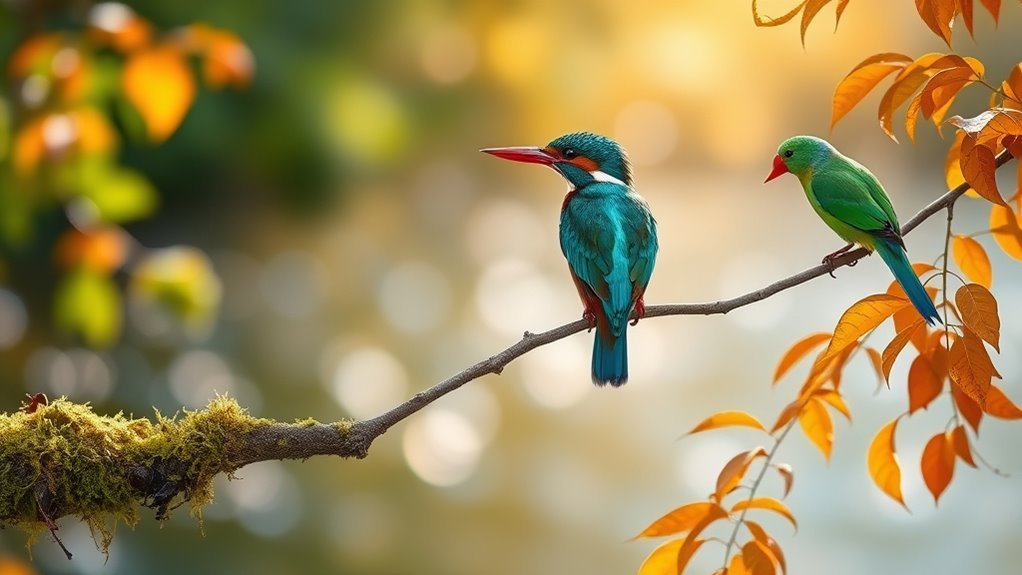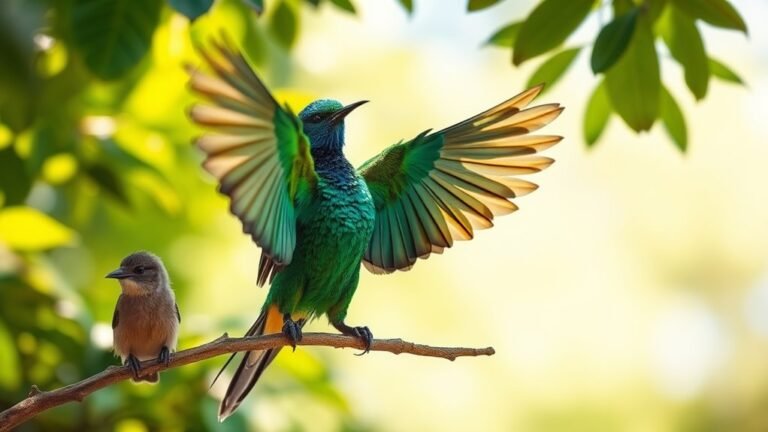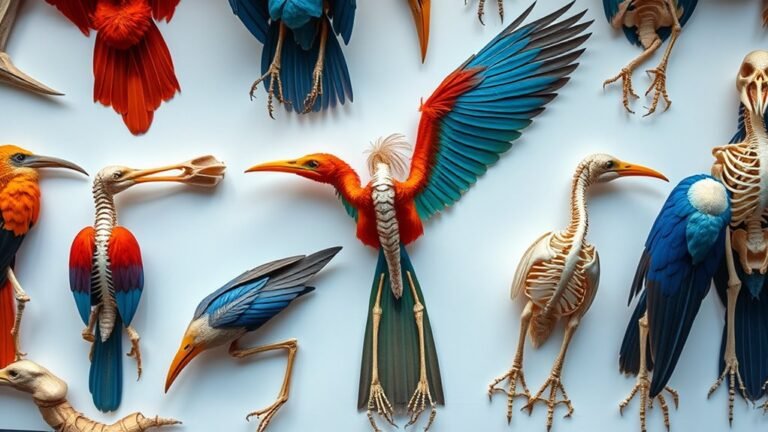10 Exotic Birds You Can Spot in the UK
If you're interested in spotting exotic birds in the UK, you're in for a treat. You might see the colorful Rose-ringed Parakeet flying through urban gardens or the beautiful Eurasian Jay resting in woodlands. Each bird adds something special to the UK's avian diversity. Would you like to know about more species? Let's discover the exciting birds waiting for you to find.
Key Takeaways
- Exotic birds like the Rose-ringed Parakeet are common in urban parks and gardens, showcasing their bright green feathers and social behavior.
- Monk Parakeets thrive in cities, noted for their green body, social flocks, and impressive multi-tree nests.
- The Eurasian Jay, with its vibrant plumage, is often spotted in woodland areas, exhibiting playful and curious foraging patterns.
- Egyptian Geese, recognized by their chestnut and gray feathers, gather in groups near lakes and wetlands, adding to the vibrant birdlife.
- The Great Egret, with its striking white feathers, can be seen wading gracefully in shallow waters, hunting for fish in various wetland habitats.
Rose-ringed Parakeet

The Rose-ringed Parakeet has bright green feathers and a unique rose-colored neck. These birds are common in the UK. They like urban areas, such as parks, gardens, and woodlands. These habitats provide shelter and food.
Rose-ringed Parakeets eat seeds, fruits, and nuts. They show adaptability in their feeding habits. You may see them foraging for food in groups and interacting with other birds.
These social birds remind us of the joy of connection and community. Watching their behaviors allows us to appreciate nature and feel a sense of belonging among our feathered friends.
Monk Parakeet
The Monk Parakeet is a colorful bird often found in urban areas, where it shares habitats with the Rose-ringed Parakeet. This bird has an olive-green body and a grayish breast.
You can spot them in city parks and gardens, where they thrive and adapt well. Their friendly nature makes them fun to watch as they chirp and play.
Here are three key traits of the Monk Parakeet:
- Social Birds: Monk Parakeets often gather in flocks, forming a close community.
- Nest Builders: They construct large nests, sometimes using multiple trees or structures.
- Vocal Birds: Their calls and whistles add energy to city life.
Keep an eye out for these lively birds; they bring joy to your environment!
Eurasian Jay

The Eurasian Jay has bright feathers and is often seen in British woodlands and gardens.
These birds like oak and beech forests, where they find food and spend their time.
They're playful, chasing each other and moving their heads as they look for acorns and insects.
If you watch quietly, you may see their curious behavior as they explore.
The Eurasian Jay's unique call adds energy to its surroundings, making it a memorable part of birdwatching.
Next time you're in nature, look for these colorful birds!
Egyptian Goose
Egyptian Geese have a striking appearance and are an interesting sight in the parks and wetlands of the UK. Their chestnut and gray feathers make them easy to identify.
To spot these unique birds, watch for these three traits:
- Habitat: Egyptian Geese are often near lakes, rivers, and marshes. They enjoy being around water.
- Sound: These geese are quite vocal. They make honking sounds that can be heard from a distance.
- Groups: Egyptian Geese like to travel in groups. They show strong social bonds with one another.
Keep these points in mind to increase your chances of spotting these beautiful birds.
Great Egret

The Great Egret is a stunning bird known for its white feathers and long body. You can often see them wading in shallow waters of wetlands and coastal areas in the UK.
They hunt for fish and amphibians, moving gracefully as they find their food. Great Egrets prefer habitats like marshes, estuaries, and lakes.
During migration in late summer and early autumn, they fly, showing off their large wingspan. Spotting a Great Egret can inspire awe about nature's beauty and highlight the need to protect our ecosystems.
Take the time to observe this amazing bird in its habitat!
Red-crested Pochard
The Red-crested Pochard is a beautiful bird in the UK. You can find these ducks in freshwater lakes and marshes. They thrive in these environments.
During the breeding season, you may see them display interesting behaviors as they attract mates and build nests.
Here are three key features of the Red-crested Pochard:
- Coloration: Male Red-crested Pochards have a bright chestnut body and a striking red crest. Female Pochards have more muted colors.
- Breeding Behavior: Males perform elaborate displays to attract females. They often dive and splash in the water during these displays.
- Nesting: They usually build their nests in hidden spots among reeds, which helps protect their young from predators.
Next time you visit a lake or marsh, watch for these captivating birds!
Little Egret
In the wetlands of the UK, you may see the graceful Little Egret. This bird stands out with its white feathers and slender neck. It represents the success of habitat conservation efforts.
As you observe, you'll notice how it hunts small fish and crustaceans. The Little Egret wades through water, using its sharp bill to catch its food.
The presence of the Little Egret highlights the need to protect wetland ecosystems. By preserving these areas, you support this beautiful bird and many other species that rely on the same habitat.
Enjoy birdwatching and connect with the beauty of nature!
Black-winged Stilt
As you explore the shallow shores of the UK's wetlands, look for the striking Black-winged Stilt. This bird stands out with its long legs and graceful posture, adding beauty to the scene.
Here are some interesting facts about the Black-winged Stilt:
- Nesting: The Black-winged Stilt builds nests in shallow water, laying eggs in small scrapes among reeds or mud.
- Migration: These birds arrive in the UK in spring, migrating from warmer areas to breed.
- Feeding: Their diet mainly includes insects and small crustaceans, which they catch by wading through the water.
Watching these elegant birds move through the water is truly a joyful experience.
Mandarin Duck
The Mandarin Duck is a beautiful bird that attracts the attention of birdwatchers and casual viewers. Its bright colors and distinct features make it hard to miss.
You can often see these birds in parks and gardens, where they enjoy quiet lakes and streams—perfect places for their playful actions.
Watch them as they perform courtship displays, bobbing their heads and moving smoothly across the water. On land, they search for seeds and insects to eat.
Their ability to adapt helps them live alongside local species, adding joy to the birdlife in the UK. Enjoy the charm of the Mandarin Duck!
Yellow-legged Gull
The Yellow-legged Gull is a notable bird found in the UK, commonly seen along coastlines and urban areas. It adapts well to various habitats, including sandy beaches and busy docks.
Watching their behavior can be quite entertaining, as they're skilled scavengers and vocal communicators.
Here are three key traits to notice:
- Distinctive Appearance: Yellow legs and a strong body set them apart from other gulls.
- Vocalizations: Their sharp, loud call shows their confidence.
- Social Dynamics: They often gather in flocks and interact playfully, demonstrating their social nature.
Frequently Asked Questions
Are These Exotic Birds Native to the UK?
Exotic birds are not native to the UK, but seeing them can make your birdwatching more exciting. When you explore different bird habitats, you will find interesting species that add joy to your nature outings. These encounters create memorable experiences for bird lovers. Enjoy the beauty of nature and the thrill of spotting these unique birds!
What Is the Best Time to See These Birds?
The best times to see exotic birds are early in the morning and late in the afternoon during spring and summer. Birds are more active during these times. You can enjoy their beauty and lively behaviors.
Do These Birds Migrate From Other Countries?
Yes, many birds migrate to find food and suitable nesting sites. They travel long distances during spring and autumn. You can see their seasonal movements as they begin their journeys. These migrations are important for their survival and help them adapt to changing environments.
Are Exotic Birds Protected by Law in the UK?
Yes, exotic birds are protected by law in the UK. These laws help conserve their populations and habitats. By understanding these protections, you support the preservation of wildlife in the UK. Protecting these birds is important for maintaining biodiversity. Enjoy learning about exotic birds and their role in nature!
How Can I Attract These Birds to My Garden?
To attract exotic birds to your garden, place bird feeders filled with seeds. Add native plants to provide natural shelter. Create a friendly environment. You will soon see these beautiful birds enjoying your garden.

Hello, I’m Emily Price, the founder of Birds Affection. As a passionate bird enthusiast and spiritual seeker, I’ve always been fascinated by the symbolic meanings and mystical connections between birds and our lives. On this website, I share my knowledge and insights on the spiritual significance of various bird species, exploring their roles as messengers, guides, and teachers. Through my writing, I aim to inspire and educate others on the profound wisdom and beauty that birds bring to our world. Join me on this journey as we delve into the enchanting realm of bird symbolism and discover the hidden meanings behind these magnificent creatures.







